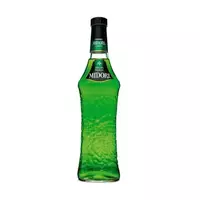Midori liquor

Midori liqueur rightly deserves special attention, and not only for its exquisite taste, but also for its unsurpassed aroma. Interestingly, when in the early 80s of the 20th century, the giant of the Japanese food industry in the field of drinks - Suntory - first launched Midori liqueur on the market, this bright green product in a small textured bottle almost instantly became a real hit.
By the way, direct acquaintance with this bright fragrant liquor began with a grandiose party, which took place in the most fashionable nightclub in the world at that time, Studio 5
4. This institution is located in New York, USA. Despite the fact that Midori liquor was originally produced in Japan, starting in 1987, it began to be produced in Mexico. Since 2003, Midori liquor has also been produced in France, namely at the facilities of Louis Royer (cognac house), which was affiliated with Suntory back in 198
9.
The flavoring component of Midori liquor is melon, which is quite unusual in the world of such drinks, but its saturated green hue is achieved by artificial tinting. We can say that this bright color is the main bait for the consumer. In addition, the word Midori itself means green in Japanese.
According to the idea of the creators of Midori liquor, the color of the drink, apparently, should suggest the color of the melon skin of certain varieties, since it is the skin, not the flesh, that is used in the process of making Midori liquor as a flavoring agent. By the way, according to true connoisseurs of this drink, in smell and taste it does not resemble melon, but rather a banana.
Midori liqueur is an excellent component for making a variety of cocktails. For example, Green Caribbean is widely known and popular, which is based on white rum, Midori liqueur, soda, lemon and ice cubes. In addition, many people like the Green Iguana (Green Iguana) cocktail, which is a variation on the Melon Margarita (Melon Margarita) theme. Cocktails such as Suntory Cocktail and Japanese Slipper are also being prepared.
Experts do not recommend serving Midori liqueur in its purest form, basing it on the fact that this is how its subtle aroma quickly evaporates. It works perfectly with fruit juices, especially orange juices. Additionally, some restaurant chefs use Midori liqueur in tropical fruit-based desserts: pineapple, mango or melon salads.
midori liqueur 140 kCal
Energy value of midori liquor (Ratio of proteins, fats, carbohydrates - ju):
Proteins: 0 g (~ 0 kCal)
Fats: 0 g (~ 0 kCal)
Carbohydrates: 39g (~ 156kCal)
Energy ratio (bj | y): 0% | 0% | 111%
 Español
Español Français
Français Português
Português Русский
Русский 简体中文
简体中文 繁體中文
繁體中文 日本語
日本語 한국어
한국어 العربية
العربية Türkçe
Türkçe Қазақ
Қазақ Deutsch
Deutsch Italiano
Italiano Українська
Українська
